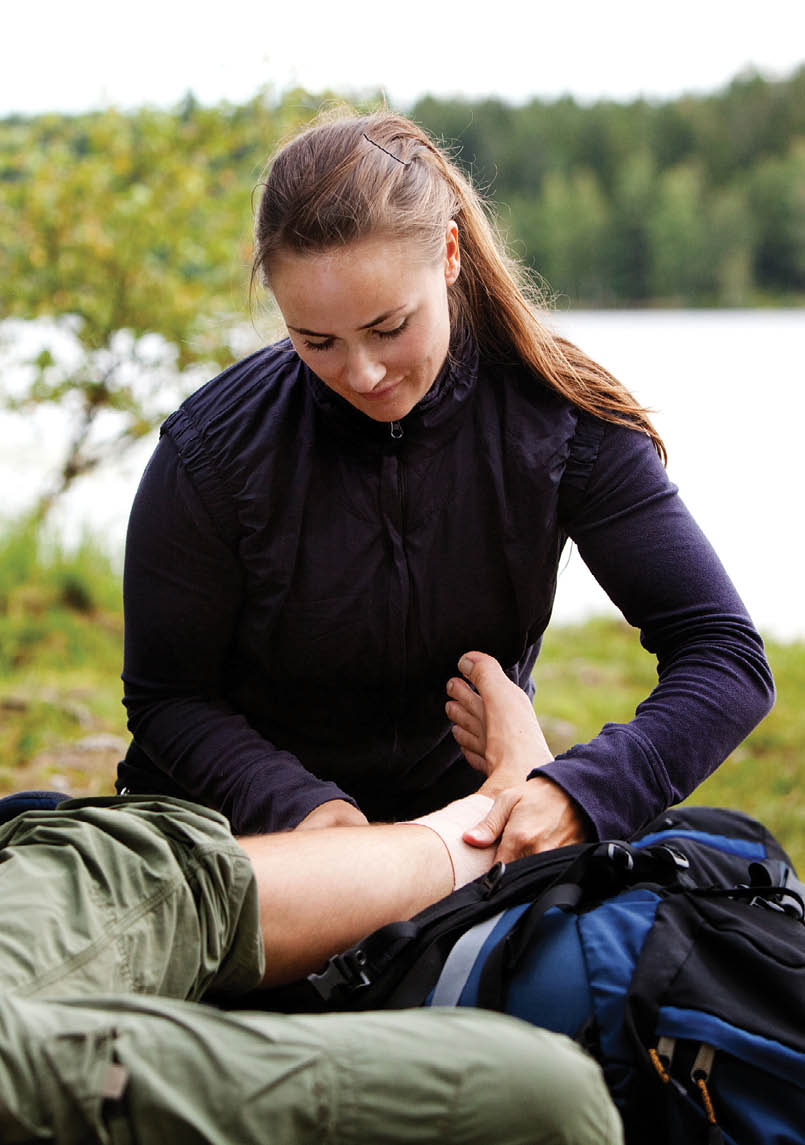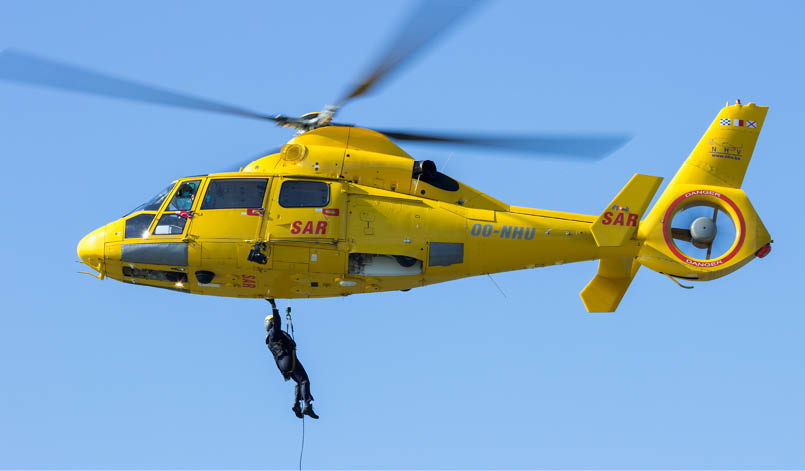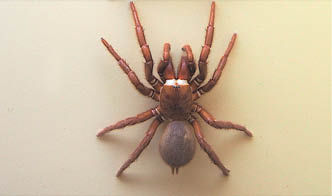


Bushwalking Safety, Medical and Rescue FAQs
Wildwanderer

The Australian bush is an amazing place to explore. The environments and challenges are varied, from seaside walks on well-formed tracks to off-track adventures in unpredictable alpine locations. There a few dangers to watch out for and suggested ways to prepare for an off the beaten path adventure so you maximise the fun and minimise the risk.
56 | BWA August 2018


The bushwalking FAQ below attempts to list information that I hope will enhance your safety and enjoyment when in the Australian bush. It’s the culmination of knowledge from many people in the bushwalking and wider communities and will be most useful to those who are just starting out or returning to the bush after a bit of a break.
It’s also a handy reference for what to do in the unlikely event something does happen on a trip, who to contact and what first aid steps to take while waiting for help to arrive. And of course, some suggestions to avoid running into trouble in the first place!
The following information is general in nature and may not be suitable for your specific circumstance. Use your own judgement. Use this information at your own risk.
Before you goFamiliarise yourself with the walk route and make sure you can read the map you are carrying. Give a written copy of the route to your family or friend. Tell them what time you are expected back.
Check the weather service and the local fire service (to see if any fires are in the area). Check the park authority for any closures. You don’t want to arrive and find the walk area is closed.
Remember to respect the environment by carrying out all rubbish. Do not leave spare food for other walkers. Do not cut down living trees for firewood/bushcrafting.
What to take on most bushwalksThe following is for day walks in temperate environments.
Water On hot days for full day walks you may require more than three litres. Even on a cool day for a half day walk 500 ml is not enough if you have no other source of water.
Carry a pack, mobile phone, map and compass, (a Personal Locator Beacon (PLB) is strongly suggested), rain jacket, warm jacket, light weight first aid kit including blister treatment, food, heat reflective emergency blanket. Whistle/bright item of clothing/loud voice to attract attention if lost, needing help etc.
Wear light weight comfortable clothing appropriate for the conditions. Hat! Light weight comfortable athletic/outdoor shoes you have walked in extensively before (or lightweight outdoor boots if you prefer but generally not needed).
The above list is the minimal essentials. You will need to adjust what you are carrying according to the length and climate/environment of your walk.
Be aware that if you're bushwalking in off-track or remote locations or in areas subject to significant weather conditions then you
“... culmination of knowledge from many people in the bushwalking and wider communities ...
BWA August 2018 | 57
should carefully evaluate your clothing, food and equipment requirements and supplement your gear list accordingly.
If walking in hot, dry, cold or wet areas the list varies.
Hot and/or dry Extra water, a broad brim hat, long sleeve shirt, maybe long pants.
Cold Warm clothing, thermal underwear, beanie or hat, gloves, high-energy food, perhaps a stove and billy for a hot drink.
Wet A bushwalking blizzard jacket, either long enough to sit on or with overpants.
What to do if unsure of your location in the bush/wildernessStop As soon as you realise you're uncertain of your approximate location: stop, stay calm, stay put. Panic is your greatest enemy.
Think Go over in your mind how you got to where you are. Look at your map. What landmarks should you be able to see? Are you still on the track? Get your compass/map and determine the directions of landmarks based on where you think you are located.
Plan Based on your thinking and observations, come up with an approximate location of your present position and a route
to another safe and known location that is easy to identify (it could be the car park or a track sign). Carefully proceed to the safe and known location. However, if after evaluating the above you are still not sure of your approximate present position and a route to the safe and known location then you are probably lost.
If you determine you are lost you should strongly consider contacting emergency services. If you're lost stay in your present location or move to a nearby location that is more easily visible from the air. Use bright clothing, a reflective emergency blanket, a mirror, a whistle, or your voice to attract attention.
Contact emergency services for rescue if
You or a member or your walking party is lost; or
Significantly injured or ill to the point where you cannot safely self evacuate; or
Are bitten by a snake or venomous spider.
Emergency numbers in Australia000 is the standard emergency number for Australia. 000 can be called from any mobile phone and landline. It may (but is not guaranteed) to work from VOIP internet

“... stop, stay calm, stay put. Panic is your greatest enemy.
58 | BWA August 2018
telephone services such as skype. The 000 service uses any network, so if an Optus phone that cannot get connected will use Telstra if is available.
112 is the international digital mobile phone emergency number. It will connect you to 000 and can be used as an alternative. It is not any faster than calling 000 directly. 112 can only be used from a digital mobile phone.
Using SMS (text) to contact emergency services. As a last resort if the mobile phone reception is inadequate for a call to connect then it's possible to use the SMS service provided by the National Relay Service. A relay operator will receive your SMS and then contact emergency service on your behalf. Here’s more information on how to use the service. They also have a helpful video. Keep in mind that this service is designed for people with hearing/speech impairments so using it for the alternate purpose of contacting emergency services while bushwalking is not what it was designed for and it should only be used as a last resort.
Emergency app In an emergency situation you can use the following app to display your current location coordinates on your GPS-equipped mobile phone. It will work without a data connection however you will not be able to call emergency services and give them the co-ordinates (in an emergency situation) if you do not have a mobile phone signal/reception at that time. A PLB does not have this limitation (see below section).
Mobile phones
Be aware you may not have mobile phone coverage in the area you are walking, especially in valleys (even if close to a town).
If coverage is weak, your phone battery will be used up much quicker due to the extra power required to maintain a weak signal and/or search for a signal.
When walking switch your phone off and only use in an emergency. If you must use your phone (to take a picture etc) then keep it on flight mode for the duration of the walk as this will conserve the battery.
GPSs and bluetooth use significant battery, so be sure to turn them on only when actively using. Then turn off.
Personal Locator Beacon (PLB)These are small lightweight devices, typically under 300 grams, that can be used in any location worldwide. They do not require a mobile phone signal/reception as they use the global satellite system to track and locate activations. This system provides 24 hour coverage across the globe. For details on when to trigger a PLB see bushwalking101.org/when-to-activate-a-plb/
When a PLB is activated a signal will be sent to the nearest rescue co-ordination centre which will organise a rescue response to the location of the PLB. The PLB transmits its location with an accuracy of up to 100 metres.
“... in a valley or a densely forested area it may take more time for the signal to get through ...

KTI Safety Alert PLBSource: Snowys.com.au
BWA August 2018 | 59
PLBs require a line of sight to satellites to work. Hence, if the PLB is located in a valley or a densely forested area it may take more time for the signal to get through, up to several hours. If the PLB is located at a high point such as a hill or cliff top it has many more opportunities to have line of sight to multiple satellites and therefore the signal can get through much more quickly, potentially within a few minutes.
PLBs do not work in a cave or anywhere there is no view or an extremely limited view of the sky. Activate the PLB at a nearby location with clearest view of the sky possible. PLBs only work when activated, which is done at the time of the emergency, not at the start of the walk.
You can borrow a PLB free of charge from some New South Wales Police stations (Blue Mountains) and it is possible to hire it in other locations around Australia.
In some locations, especially countries with limited Search and Rescue (SAR) resources a SAR response may take a long time to arrive, perhaps hours or days.
Some common dangers in the bush
Pay attention to foot placement. Slippery and unstable rocks, uneven surfaces and ground level sticks can cause a fall or injury.
Watch for face level branches. These can injure your eye/face. Don’t walk close behind someone as a branch may spring back and hit you.
Respect heights. Don’t move quickly around cliffs and high places. Watch out for moss and wet rock which can cause you to slip. Don’t dislodge rocks, you don’t know who is below you.
Do not wade across a waterway unless you have experience in doing so or are with someone who has experience and knows the correct safety precautions. Do not wade across a waterway that is in flood or moving swiftly.
Be aware of overhanging branches when pitching a tent. There is a chance (though unlikely) they could fall during the night due to wind or temperature fluctuations. Pitch your tent in an area with open sky above you if possible.
Be careful around fires. Always completely extinguish a fire before leaving. If the dirt in a fireplace or the remaining wood is still hot, the fire is not out. Always obey fire bans.
Be aware that walking solo can be riskier. Solo walkers should consider carefully if their experience, clothing/equipment and route knowledge is sufficient for the bushwalk being undertaken.
Stick together when walking in groups. If you need to stop let the others in your group know. Always pause at track junctions and ensure your entire group takes the correct track.
In early spring, be especially vigilant for snakes. During this time many snakes will come out of their winter low activity period and be warming themselves on trails and rocks. Never try to touch or kill a snake. Many bites are the result of people touching or attempting to kill snakes.
Snake biteA snake bite should always be treated as a venomous bite. Several snakes in Australia can cause death in under a few hours if they bite you and you fail to receive adequate first aid or medical treatment.
If bitten by a snake or strongly suspect you have been bitten:
Remove yourself and the patient several metres from the snake's location/danger.
Do not move. Moving will rapidly increase the opportunity for venom to travel through your body and reach critical areas (which could cause loss of life).
Immediately wrap the bitten limb or body part with a compression bandage as this will slow the venom travelling through your system. Suggested bandage – Setopress. This is a specially designed bandage with indicators guiding the correct amount of compression (tightness of wrap). Most chemists can order this in for you, $12-20. A splint can be useful to prevent limb movement.
“Activate the PLB at a nearby location with clearest view of the sky possible.
60 | BWA August 2018
Activate your PLB, or if there's mobile phone coverage call 000.
A snake bite will not always be visible as the tips of some snake fangs are like pin pricks/small. It can be painless.
If you see a snake lunge for you and the snake head impact your body assume you have bitten even if you cannot see or feel a bite.
Gaiters may provide some protection against lower leg snake bites however there is limited evidence to support this other than theory.
Do not wash the bite site. As venom on skin may help identification and appropriate treatment once patient has been transferred to hospital.
Spider biteSeveral spiders in Australia can cause death in under a few hours if they bite you (and you fail to receive adequate first aid/seek medical treatment).
The most dangerous spiders include:
If bitten by spiders that look like a funnel web or mouse spider treat as for snake bite. Immediately apply compression bandage, don’t move and contact emergency services for medical evacuation.
Please refer to St John Ambulance advice on treatment of redback spider bite.
Do not wash the bite site. Venom on the skin may help identification and appropriate treatment once patient has been transferred to hospital.
Injuries and other medical symptoms
Take a first aid course to learn how to respond to various injuries/medical symptoms.
If you cannot safely self-evacuate consider contacting emergency services for evacuation.
It's strongly recommended to delve beyond the basic information above.
There is a lot of great information in the Bushwalk.com forum, including discussion on first aid kit contents, what should you pack for an overnight walk, suggested bushwalking foods, day and multi-day walk suggestions for all areas of Australia etc. The forum search box is your friend. Read the discussion that led to this article.
The author wishes to acknowledge the many suggestions and additional information provided by members of the Bushwalk.com forum during the preparation of the FAQ.

A male Mouse spiderPeripitus via Commons.wikimedia.org/CC BY-SA 3.0
Female funnel web spider. They can also be black.Sputniktilt via Commons.wikimedia.org/CC BY-SA 3.0

Red-bellied black snakeFotolia Premium

BWA August 2018 | 61